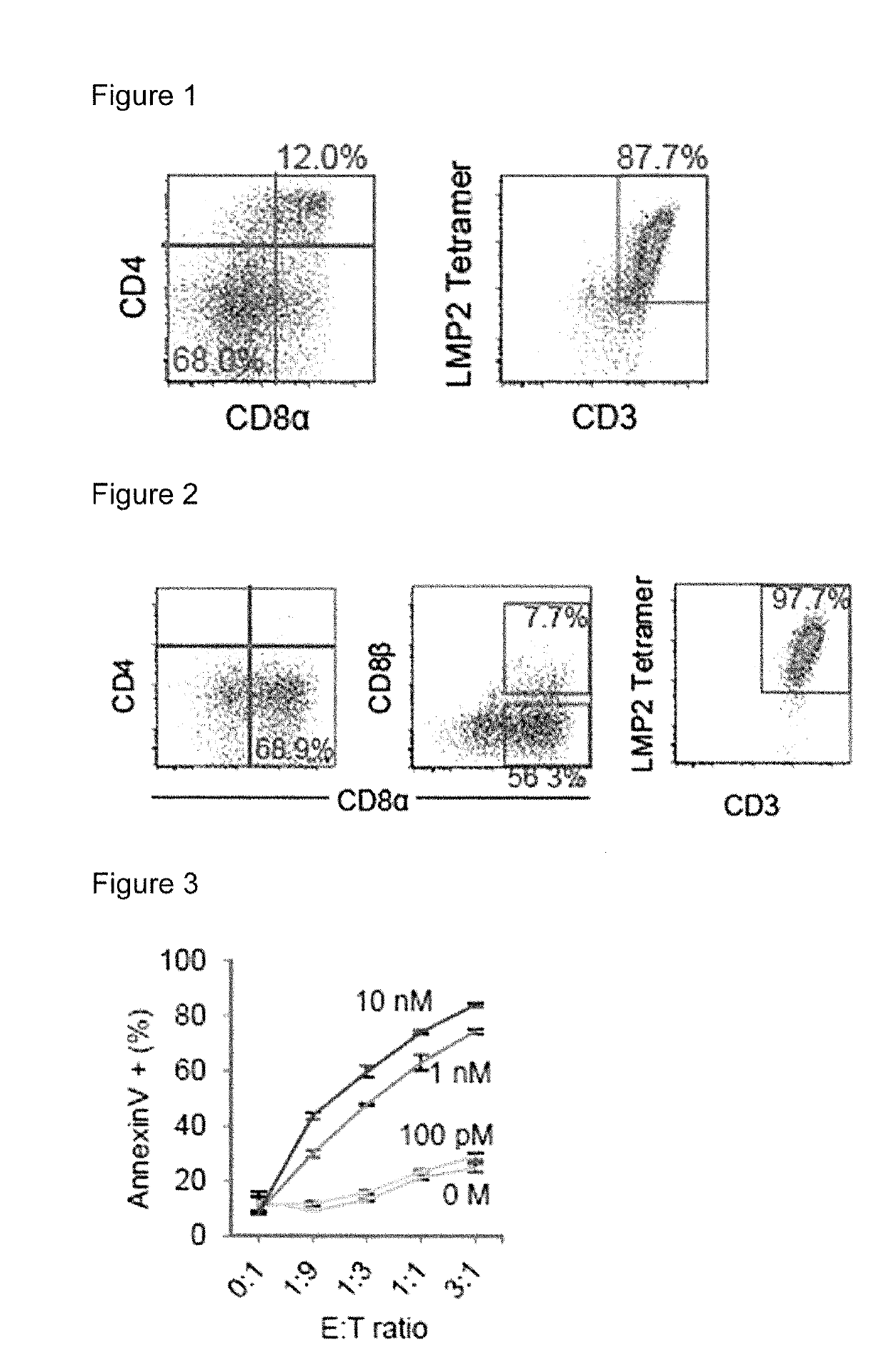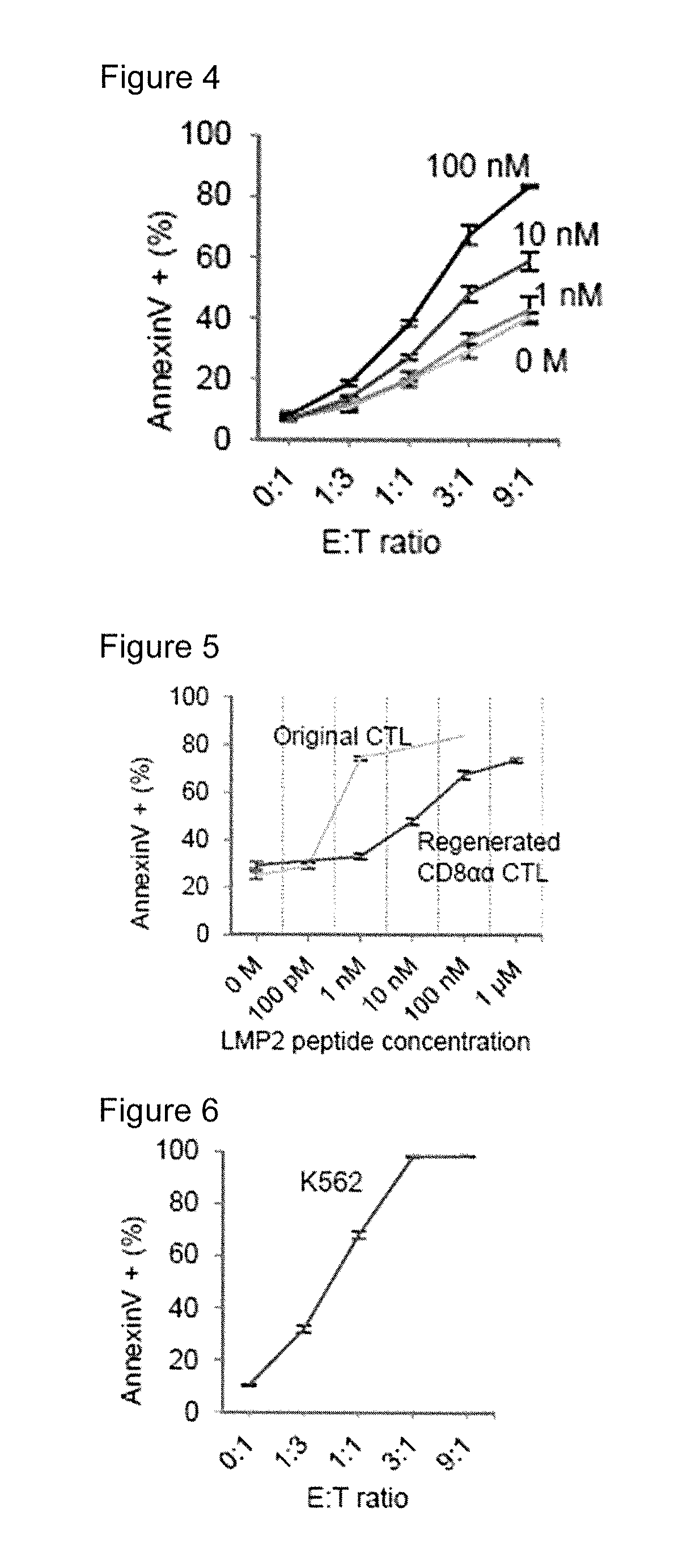Method for inducing antigen specific cd8 positive t cells
- Summary
- Abstract
- Description
- Claims
- Application Information
AI Technical Summary
Benefits of technology
Problems solved by technology
Method used
Image
Examples
reference example 1
Establishment of iPS Cells
Preparation of Peripheral Blood Mononuclear Cells, Auto LCL Cell Line and CIR-A*24:02 Cell Line
[0103]Peripheral blood mononuclear cells (PBMC) were isolated from a healthy volunteer having HLA-A*24:02, and bone marrow mononuclear cells were isolated from a leukemia patient according to the conventional procedure. The peripheral blood B lymphocytes were transformed with Epstein Barr virus (EBV) to give autologous B-lymphoblastoid cell line (auto). HLA-A*24:02 gene was introduced into human LCL cell line, C1R cells to give C1R-A*24:02 cell line that expresses only HLA A*24:02.
Proliferation of LMP2 and WT1 Peptide Specific CTLs
[0104]PBMCs obtained from the healthy volunteer (2.5×105 cells) were added to each well of a 96-well round bottom plate and incubated in RPMI 1640 medium added with 10% human AB serum (Sigma), penicillin (100 U / mL)-streptomycin (100 μg / mL) mixed solution (Nacalaitesque) and 10 μg / mL of a LMP2 specific synthetic peptide (TYGPVFMSL: SEQ ID...
example 1
[0111]LMP2-T-iPS cell clone obtained in reference example 1 was used. T cells were re-generated from the T-iPS cells according to the procedure explained in FIG. 7.
1) Differentiation from T-iPS cells into a cell population comprising DP cells and DN cells.
Media used are as follows:
TABLE 1Medium A: for maintenance of OP9 stromal cellscontentsamount addedfinal conc.αMEM medium500mLFCS125mL20%penicillin-streptomycin6.25mL 1%solution*Total631.25mL*Mixture of Penicillin (10,000 U / ml) and Streptomycin (10,000 μg / ml). The final concentrations were 100 U / ml and 100 μg / ml, respectively.
TABLE 2Medium B: for inducing differentiation of T cells No. 1contentsamount addedfinal conc.Medium A50mLhrIL-7 (stock: 10 μg / mL)25μL5 ng / mLhrFlT-3L (stock: 10 μg / mL)25μL5 ng / mLhrSCF (stock: 10 μg / mL)25μL5 ng / mLTotal50.75mL*Mixture of Penicillin (10,000 U / ml) and Streptomycin (10,000 μg / ml). The final concentrations were 100 U / ml and 100 μg / ml, respectively.
TABLE 3Medium C: for inducing from immature T cells i...
reference example 3
Co-Culture of the DP Cells and DN Cells
[0137]According to the same protocol as Example 1, cells of the LMP2-T-iPS clone obtained in reference example 1 were incubated until day 40. The obtained cell culture was sorted into DP cells and DN cells. DP cells and DN cells were labelled with Cell Trance Violet and CFSE, respectively. The purity of both DP cell population and DN cell population were more than 99%. 3×104 of the DP cells were mixed with DN cells to give DP:DN ratio of 1:0, 3:1, 1:1 and 1:3 and then, incubated in the presence or absence of anti CD3 antibody for 5 hours. Thus obtained cells were stained with Annexin V and PI (Propidium Iodide) and the Annexin V-negative and PI-negative cell fraction was determined as viable cells. Viable cells among the Violet positive cells, i.e. DP cells and viable cells among the DP cells at the start of the co-culture are shown in FIG. 14. It was shown that the DN cells killed DP cells under the stimulation of anti CD3 antibody.
PUM
 Login to View More
Login to View More Abstract
Description
Claims
Application Information
 Login to View More
Login to View More - R&D
- Intellectual Property
- Life Sciences
- Materials
- Tech Scout
- Unparalleled Data Quality
- Higher Quality Content
- 60% Fewer Hallucinations
Browse by: Latest US Patents, China's latest patents, Technical Efficacy Thesaurus, Application Domain, Technology Topic, Popular Technical Reports.
© 2025 PatSnap. All rights reserved.Legal|Privacy policy|Modern Slavery Act Transparency Statement|Sitemap|About US| Contact US: help@patsnap.com



